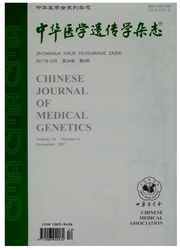

 中文摘要:
中文摘要:
目的探讨过氧化物酶增殖体激活受体-γ(peroxisome proliferator—activated receptor-γ,PPAR-γ)基因外显子B的Pr012A1a变异与类风湿性关节炎(rheumatoid arthritis,RA)的关系。方法应用聚合酶链反应-限制性片段长度多态性及琼脂糖凝胶电泳法测定无血缘关系的421名四川地区汉族人(包括207例类风湿性关节炎患者及214名健康志愿者)PPAR—γ基因外显子B的Pro12Ala变异。结果在类风湿性关节炎组和健康对照组中PPAR—γ基因中P等位基因的分布频率分别为98.79%、95.79%;A等位基因的分布频率分别为1.21%、4.21%;PP基因型频率为97.58%和91.59%,PA基因频率为2.42%和8.41%,AA基因频率都为0。两组人群的基因型和等位基因频率分布差异具有统计学意义(P《0.05)。RA组中PPAR—γ基因Pro12A1a的A等位基因的分布频率(1.21%)明显低于健康对照组(4.21%)(P〈0.05)。结论PPAR-γ基因外显子B的Pro12A1a变异可能与风湿性关节炎发病有关,A等位基因可能对类风湿性关节炎有保护作用;中国四川地区汉族人群PPAR—γ基因的Pro12A1a多态性的分布频率与其他地区黄种人群相近,与欧美人群差异较大。
 英文摘要:
英文摘要:
Objective To investigate the association of the Pro12A1a variant in peroxisome proliferator-activated receptor-y (PPARγ) gene with rheumatoid arthritis. Methods The genotypes of the Pro12A1a variant in the PPARγ gene were determined by polymerase chain reaction-restriction fragment length polymorphism in 421 unrelated subjects of the Han population in the Sichuan Province of China, including 207 subjects with rheumatoid arthritis and 214 subjects without the disease. The clinical data were also collected and analyzed. Results The allele frequencies in the ease and control groups were 98.79%, 95.79% for allele P and 1.21%, 4.21% for allele A; the genotype frequencies were 97.58% and 91.59% for PP, 2. 42% and 8.41% for PA, and 0 for AA. The A allele frequency was much lower in the RA group than that in the control group. Conclusion The above data showed that the Pro12A1a variant of the PPARγ was associated with rheumatoid arthritis. The A allele might be a protective factor for RA. The Prol2Ala polymorphism in the PPARγ gene in Sichuan Han population is similar to that in other populations in China, but different from that in European and American populations.
 同期刊论文项目
同期刊论文项目
 同项目期刊论文
同项目期刊论文
 期刊信息
期刊信息
